
Lexus has long pursued a stronger visual identity within the premium echelons of the car market. It’s what resulted in the now familiar – and unquestionably distinctive – ‘spindle’ grille, which made its first appearance on the fourth-generation Lexus GS back in 2012.
Four years is a long time in the automotive world, however, so the Japanese marque has ushered in a facelift for its BMW 5-series rival.
As facelifts go, it’s rather subtle isn’t it?
Lexus’s styling is going through something of a dramatic transition at the moment, evidenced by the IS, RC and recent Detroit debutant, the LC 500, all following the LFA’s angular form. By contrast the tweaked GS looks a tad podgy about the flanks, but its extremities have been fettled.
The alterations are more obvious front-on, with the grille now being even larger and protruding further forwards with greater visual aggression. It’s somewhat at odds with the GS’s character, it transpires.
While the new prow errs – just – on the right side of garishness, the headlamps have enjoyed a less successful revamp. There’s now a trio of LED projectors forming the main unit, while the signature Nike-esque swoosh of daytime running lights now sits separately within the bumper moulding. It looks incongruous on the GS’s snout, akin to similar sports company symbology adorning the sneakers of a septuagenarian.
Things are more restrained out back with the light units remaining the same shape as before, albeit with new LED-dominated lighting within their confines.
So bigger changes for the Lexus GS’s cabin then?
You’d think so, but no. Be under no misapprehensions, mind, the cabin quality is superb – not in terms of Audi-aping squidgy plastics but in the sheer solidity of its construction. It also packs a standard equipment roster that’s bristling with features its competitors leave on the options list.
Even the entry-level GS300h Executive Edition, weighing in at £33,495, enjoys the firm’s uprated suite of active safety systems, heated and electrically adjustable leather seats and steering wheel, keyless entry, a 12-speaker audio system and bi-LED headlamps. Spec a BMW 520d SE to a similar amount and you’ll be forking out the thick end of an extra £8,000.
It’s not all rosy, though. That fiddly Remote Touch Interface toggle remains the key method for interacting with the 12.3-inch wide infotainment screen, while the sat-nav itself is blighted with graphics that could have been designed in MS Paint.
Plus there’s a mish-mash of switchgear types with rotary dials for this, buttons for that and a lever for the other. By which we mean the CVT gearbox.
A CVT? Not the kind of car that enjoys being hustled along I guess?
Lexus’s forte is delivering cars that go about their business effortlessly, responding best to gentler driver inputs in order to coax the greatest degree of efficiency from the petrol-electric drivetrain.
A raft of modifications have been introduced to reduce the four-cylinder Atkinson cycle engine’s thirst for petrol as well as subduing NVH levels. Of greater interest to a company car driver’s bank balance, however, is that the GS300h Executive Edition emits just 104g/km of CO2 – partly thanks to its 17-inch rims. There’s no 3% diesel Benefit-In-Kind surcharge here either.
Despite a combined power output of 220bhp the Lexus’s portly 1730kg girth stymies performance, as it requires nine seconds to reach 62mph from a standstill. Still, the claimed fuel economy is 64.2mpg on the combined cycle, so a real-world figure in the low-40mpgs is possible providing you don’t drive it with too much verve.
You’re not going to want to push on aggressively in this Lexus, anyway. Eager application of the throttle induces that familiar shrill protest from under the bonnet, as the CVT results in the stereotypical ‘high engine speed, moderate acceleration’ effect, but the electronics soon calm the transmission’s urges and serenity is resumed.
Until you approach a series of bends at speed, that is. The GS will adhere well through left-right-left flicks but there’s ample body roll to upset the comfort equilibrium. Nevertheless, ride quality when cruising is impressive.
Lexus also claims to have revised the steering to deliver a more feelsome experience but that’s not entirely successful either. BMW and Jaguar alternatives serve up a much meatier experience at the wheel, but the GS? If Quorn made steering racks…
Verdict
In a world of 2.0-litre diesel executive saloons the petrol-electricLexus GS300h is a genuine alternative to the mainstream and that in itself should be welcomed.
Nothing in the segment can rival its kit-per-buck ratio or its miserly on-paper running costs – although, admittedly, diesel alternatives are still likely to perform better on long motorway slogs. Make no attempt to press the Lexus too hard and it’ll reward you as an unruffled, indefatigable travelling companion.
If it’s not got quite the urgency you want but you still want to opt out of the Jaguar and Germanic big three car park bragging histrionics, there’s still the brisker GS450h to consider. Just don’t expect that to be a-thrill-a-minute either.
[“source-carmagazine”]





